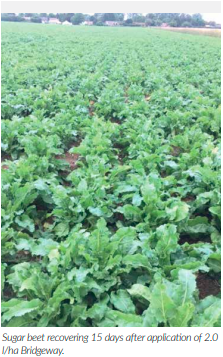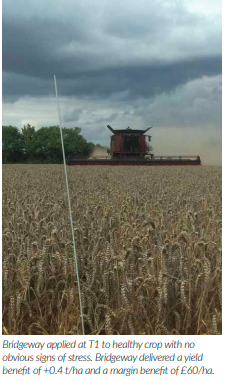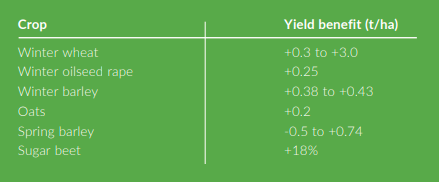By Sarah Ferrie, Marketing Manager at Interagro (UK) Ltd
Could amino acids be one of the most overlooked assets in plant nutrition? In this feature we take a look at how supplementing the crop with amino acid biostimulants in-season not only boosts plant health and development, but can also help crops reach their genetic yield potential.
On a cold wet day in summer 2017 we got our first insight into the real power of amino acid biostimulants. A crop of sugar beet on its last legs from a herbicide contaminated spray tank, had totally recovered following a single application of Bridgeway. As the agronomist put it, “it was nothing short of a miracle.” The herbicide damage was so severe that some of the beet didn’t pull through, but in others, Bridgeway had stimulated a new crown to grow. That crop went on to produce larger beet that weighed in 16% heavier than the undamaged beet in the rest of the field, with the same sugar levels.

Eighteen months on, trial upon trial later, working closely with growers and agronomists to really put Bridgeway through its paces, and we are certain that feeding a crop amino acids inseason, not only improves plant health but can produce fitter plants more capable of reaching their yield potential. Deepening our understanding of plant pathology and biochemistry underpins this belief.

What are amino acid biostimulants and why do they matter?
Biostimulants are incremental technologies to improve yield by improving plant health. They are substances with the exception of nutrients and pesticides, that have the capacity to modify the physiological processes of plants in a way that provides potential benefits to growth, development and relief from stress.
Amino acids are the building blocks of all living cells which combine together in infinite variations to produce countless different proteins critical for healthy growth and development. These proteins play a vital role in virtually every process within the plant – structural components of plant tissue; metabolic enzymes and stimulation; nutrient transport, the list goes on.
Under ideal conditions plants synthesise all 18 L-amino acids they require, which they manufacture from the raw materials carbon and oxygen in the air, hydrogen from water and nitrogen from the soil. Plants therefore depend hugely on soil nutrients. As nitrate / ammonium is one of the main elements of proteins, ag systems use nitrogen / ammonium fertilisers to replenish nutrients in the soil and aid plants in generating the needed proteins. However, these crucial raw materials can become limiting, particularly as nitrogen (and water) can either leach away in the soil or become inaccessible to the crop, as we found in many parts of the UK in 2018.
Protein deficiency in plants has huge consequences on plant health which in turn impacts quality and yield. Incapable of creating reserves, as proteins have a finite lifespan, a continuous supply of amino acids must be translated in order for plant growth and development to continue. When the raw materials to produce amino acids become limited or the crop encounters abiotic stress (such as high/ low temperatures, drought, flooding, disease/pest attacks, phytotoxicity from crop protection products) amino acid production slows and plants start to break down the proteins they have made to gain the amino acids needed to speed up recovery and repair. This occurs because the selfproduction of amino acids is extremely energy expensive and it is much more efficient to self-cannibalise than it is to synthesise amino acids from scratch.
Feeding the crop additional L-amino acids via the roots or leaf tissue inseason before, during or after a stress event ensures the plant has the necessary building blocks to prevent self-destruction and aid repair.
So, what do these amino acids do?
1. Stress defence – During periods of abiotic stress plants increase production of L-Proline to help reduce the effect and speed up recovery time. It primarily strengthens the cell wall and resistance to weather extremes.
2. Photosynthesis – the most important chemical process of plants – carbon dioxide, water and light energy are synthesized into sugars, which the plant uses as an energy source to power all metabolic processes. This process is highly dependent on the amino acids L-Glycine and L-Glutamic Acid. Both amino acids are key components for chlorophyll production which absorb the light energy for photosynthesis. Increasing these amino acids increases light absorption which increases photosynthesis.
3. Enhance nutrient uptake – by increasing the availability of nutrients to plants. Some nutrients are not available to plants due to their molecular structure, ionic charge etc. The amino acids L-Glycine and L-Glutamic acid are able to bond with these nutrients making them available to the plant. These amino acids are tiny molecules allowing them to easily move through cell membranes. Their ability to bind excess metals means they are also able to reduce metal toxicity in plants.
4. Precursors to hormones and growth factors – L-Tryptophan is involved in rooting, its required in auxin synthesis for growth and development; L-Methionine is a precursor to ethylene which stimulates ripening; L-Arginine is a precursor to cytokinin production involved in cell growth, auxiliary bud growth and leaf senescence.
5. Pollination and fruit formation – one of the most important phases of development and extremely energy intensive due to the very high levels of amino acids required. L-Histidine helps with ripening; L-Proline increases pollen fertility; L-Lysine, L-Methionine and L-Glutamic Acid increase germination; L-Alanine, L-Valine, and L-Leucine improve fruit / grain quality.
Only as a stress buster?
If crops can synthesise their own amino acids it could be argued that feeding the crop additional amino acids only makes sense to help the crop through a stress scenario.
However, crops also respond with a supplement at the critical stages of plant development, e.g. vegetative growth, start of reproduction, flowering etc. as the production of amino acids required for these critical stages are extremely energy intensive. Diverting that energy to other processes such as photosynthesis, nutrient uptake, grain fill, etc. will improve the metabolic efficiency of the plant and help the crop towards its genetic yield and quality potential.
So why Bridgeway?
For growers looking to maximise the crop’s income potential, there is no better source of amino acids. Bridgeway is a plant derived biostimulant produced to food grade quality, containing all 18 L-amino acids required by plants with a ready-to-use source of organic nitrogen.

Feeding a crop Bridgeway guarantees the supply of amino acids for building proteins and provides the most critical amino acids in higher concentration than those biostimulants based on animal sourced protein. For example – 39% higher levels of Glutamic Acid, 33% higher levels of Lysine. Only amino acids sourced from plants can be fully assimilated by crops due to the difference in chemical structure between plant sourced (L-isomer) and animal sourced (D-isomer).
The differences don’t end there. Bridgeway is certified GM free and because it is 100% plant sourced it has full backing from the Soil Association and Organic Farmers and Growers Association for use on organic crops throughout the entire life of the crop. Amino acids sourced from animals could be contaminated with heavy metals, salmonella, E.coli and pose a threat to food chain safety. It is for this reason that animal sourced biostimulants on milling wheat were banned in 2017 by NABIM and are restricted in use by a number of organisations. Bridgeway offers not only peace of mind the crop will be able to utilise all the amino acids, it also gives growers freedom to use at any growth stage, in any crop for all end markets.
Delivering results on farm
With an extensive trial and grower programme in a range of crops, it’s clear that in the right situation Bridgeway has the potential to add in the region of 3 t/ha to a decent winter wheat crop. In 2018, two different wheat crops (Relay and Skyfall) each delivered a +2.3 t/ha uplift in yield from applications at T1, T2 and T3. Both crops were exposed to heat and drought stress after the first application of Bridgeway was applied.
Nutrient analysis carried out by the agronomist on the Skyfall throughout the growing period showed the uptake of most macro and micro nutrients was consistently higher in the Bridgeway treated areas. Sugar levels measured using a digital BRIX refractometer were 23-39% higher in their leaves at every assessment throughout May and June, indicating a healthy plant that is photosynthesising well and producing the carbohydrates in the leaves and stems which ultimately will be crucial components of yield. Despite the difficult season, the treated crop went on to produce a protein sample of 12.8% versus 11.7% in the untreated.

With a range of yield increases in different crops we are working hard to understand when, where and how best to use Bridgeway to deliver the best value to growers. Look out for the next article in Direct Driller where we’ll be sharing the results of our stress and rooting work ongoing at the University of Nottingham and offer in-season advice as spring applications get well underway.

Key takeaways:
• Amino acids are the building blocks of proteins and critical to plant health
• Proteins cannot be stored so a continuous supply of amino acids must be translated for growth and development to continue
• Plants synthesise all 18 L-amino acids in good conditions but stop under abiotic stress or if nitrogen, water or air are limiting
• Feeding the crop amino acids inseason avoids self-cannibalisation & threat to yield
• Bridgeway provides all 18 L-amino acids required by plants
• Bridgeway is approved for unrestricted use in all organic crops
• For best results apply ahead of crop stress and maintain applications at the key stages of crop development
For further information please contact stuart.sutherland@interagro.co.uk


